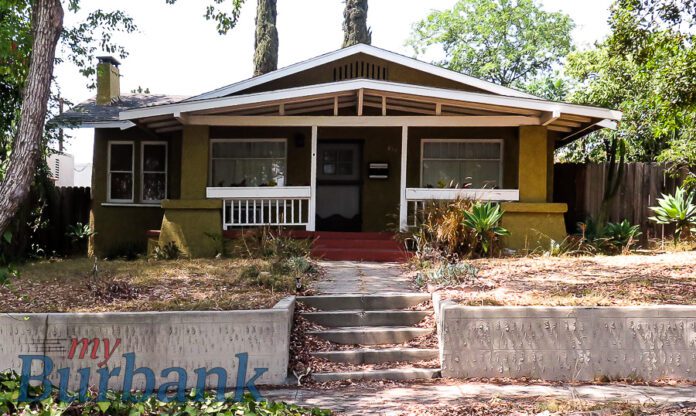Editor’s Note: This is the third in a three-part series to educate myBurbank readers and our community about the bad housing bills pending in Sacramento this year. Part Three: We look at how two similar current bills being discussed in Sacramento are doing after being adopted in Minnesota.
By Alissa D.Luepke Pier, AIA
Principal Architect
To the Citizenry of Burbank and all of California;

It is quite midwestern of me to be this unsure of how to respond to a recent development in our relationship. You see, for the past decade or so, we in Minnesota have heard many aspirational things about the wonders of west coast planning, the latest bit of dazzle from our Portland and Seattle “sister-cities”…and yet suddenly we find ourselves thrust into a new role. Instead of gawking over the latest on dit of our much cooler peers, we have somehow stolen the stage as the “it” city de jour in terms of urban planning. Everybody is talking about emulating us in this realm now.
We don’t know whether to be flattered or stoic about the whole thing. We hail from the land of Paul Bunyan – a giant of a man whose blue ox marched all over the terrain of yesteryear and created over 10,000 lakes which we still enjoy to this day…we actually have more shoreline than all of California, but we aren’t ones to brag, so that might come as a surprise to you. You’ve likely heard the myth about Paul Bunyan….and it’s equally as likely that you have never heard the stat about our shoreline. We’re fond of orating our clearly fantastical mythology here….not so much about promoting the realities of our great state.
Given this odd duality, and our well-documented, self-deprecating nature, I find it, therefore, puzzling that you appear to be falling prey to yet another bit of well-propagated lore: The great Minneapolis Myth.
I’m sure you’ve heard of it, just as sure as you pictured a flannel-wearing, bearded man holding an axe when I mentioned Paul Bunyan. It goes like this: Minneapolis solved the affordable housing crisis through the elimination of single-family zoning.
It’s a great bit of wonder. That a broad stroke of genius(?) /urban planning applied in one fell swoop over a city comprised of over 80 distinct neighborhoods was the solution to a century+ of inequities and affordability. It’s almost too good to be true.
That’s because, just like Babe the Blue Ox, it isn’t.
Minneapolis hasn’t “solved” the housing affordability crisis. And glorifying a zoning “tool” as somehow being a “goal” won’t change that, no matter how much spin and polish we put on the story. We’re a state that is passive and hesitant in acknowledging our accomplishments, which is why we are perhaps so hapless when it comes to this binge of self-promotion.

The universal upzoning of all single-family lots in Minneapolis to allow for increased density of 3-units officially took effect on January 1, 2020. We’ve now had a year and a half of this policy in place in Minneapolis. And it has not changed the trajectory of housing affordability one iota.
It is here where I feel compelled to highlight just a few points, in case these important elements get lost in this open letter to you all (one ancillary element of our passive-aggressive nature is that we tend to explain things in long, drawn-out ways….):
In all the promises about how any/all of our municipal policies would address affordable housing, can any one of you actually name a single metric for how that is being measured?
As a member of the executive committee of the Minneapolis Planning Commission, I was at the table for years of discussion on this and will attest to the absolute lack of any metric being
articulated in terms of how we would actually measure the success of any gains in this area. Was it increases in quantities of affordable units? Was it a decrease in the cost of affordable units? Was it a decrease in the number of unhoused families? I was never given an answer to exactly what (measurable) impact a policy like this might have. One might wonder how anyone could gauge the successes (or failures) of any housing policy when the actual specific goals and intended outcomes aren’t ever clearly defined, articulated, or projected.
Is density good or bad when it comes to housing?
If you find yourself advocating for density as either of these things, then please remove yourself from any policy-making position as it relates to planning and development. Very few things in this world are that cut and dried. Housing is an extremely nuanced topic. To argue a simpleton’s position over the morals of “density” as it relates to being either a savior or demon in the planning world is to elevate “density” to being in and of itself a goal to either emulate or decry. In reality, density is a mere tool. It is neither completely good nor bad. Those who are afraid of density are as naively informed as those who hail it as somehow being worthy of adulation. Ask yourself if a hammer is good or bad. It can build a house or smash a window. In and of itself, it is not a goal…it is a means of (perhaps) reaching a goal if used properly. Bottom line: please cease focusing discussions around the mere presence or absence of density. It is being deified beyond its mere mortal realities. (The ax-handle, perhaps, of our Bunyanesque mythology? …ever-present, but entirely useless in terms of actually impacting any part of the story it is associated with.)
But hasn’t universal upzoning helped Minneapolis’ affordable housing crisis?
As a 20+ year resident of the quadrant of Minneapolis most often cited as the poster-child for all things related to housing inequities and disparities, please let me share that my community is not extolling the virtues of this policy. We are seeing a continuation and acceleration of speculative absentee investors to our area, driving up housing prices (the average cost of a home in North Minneapolis neighborhoods has doubled in the past 5 years), which is leading to the displacement of my neighbors and friends. When coupled with the absentee nature of the ownership entities exploiting our neighborhood real estate, the “severely cost-burdened” nature of the households in our communities results in a capital flight of a substantial portion of our community’s wealth. This leads to the lack of funds to sustain our commercial corridors and decreases in investments in our local economy. It creates a perpetual state of reliance on benevolent subsidy (municipal or via non-profit) to maintain even the most basic elements of a livable community. (healthcare, grocery stores, pharmacies, places to purchase basic necessities.) It is eroding our ability to have the “walkable cities” that we hear lauded so often.
More “dwelling units per acre” as a means of achieving affordability in housing is impossible.
This isn’t even about debating the merits of supply-side economic theory. This gets to the heart of what our affordable housing crisis is really all about, and why we can’t seem to make headway against this problem. The people in charge of coming up with solutions don’t seem interested in actually understanding the problem. This particular facet mystifies me…. If I were attempting to solve a very complex problem (which housing affordability certainly is), I would begin by really digging into everything I could about the problem. A basic element of this would include: WHO is in need of affordable housing? I would surmise that while we need housing for single individuals, a
larger chunk that has an even harder time finding affordable housing would be housing for FAMILIES. The problem with lauding a solution that focuses on mere unit quantities is that it treats all units as equal. Those 325 square foot efficiency units might be a workable solution for an individual, but I challenge anyone to imagine having spent the better part of the past year in a studio efficiency apartment with 3 children who are attempting to do distance learning. It’s a common enough problem to understand, yet “the” solution being proposed will not lead to increased affordability for families because it dismisses this entirely predictable scenario as being a factor for consideration. (I would purport that it actually results in the further removal of family-sized units – such as a single-family home – from the market as those get gobbled up and spit out as 3 efficiency apartments in the wake up universal upzoning with no safeguards.)

I could go on, but you get the gist. Minneapolis is no closer to being a utopian beacon of affordability than it was before discussions of upzoning even started. In fact, we’re farther from achieving it as people in low-income communities like mine are experiencing 15-20% property tax increases annually due to the increased absentee investor speculation of houses nearby. We (as a city) have created tens of thousands of new units in recent years, yet no one can define what the magic tipping point is when this is suddenly supposed to result in a lower cost of housing.
You may have heard that despite our more reserved nature, “Minnesota Nice” is a very real thing – and it is. As a populace, we tend to want to help one another, friend and stranger alike. We consistently are ranked among the top when it comes to volunteerism in our country. So, it should come as no surprise that the concept of providing affordable housing to everyone is very much embraced in our state. We have a very real need for affordable housing. That, much like our many lakes, is very clear.
But that is where the reality ends. If you’re looking to address this very real need in your own communities, I would encourage you to stop looking to vague mythology for your solution. They might make for a nice story to bandy about among your political and policy-making peers, but you won’t get new lakes waiting for an imaginary giant ox to trot along, and you certainly won’t solve our affordable housing crisis by making real estate into an even more lucrative commodity for speculative investors to exploit.























More gibberish.
This time from a person who does not even live in this state. (She declines to say who her alliance is with.)
I am in favor of the free market system. It is after all, the American way. Here in Burbank we had council after council placing impediments in the way of development. I suspect many other cities were doing the same thing. This is the very reason our legislature HAD to act.
For those of us with children, we realize our kids need a place to live as well. This is not a case of NIMBY for me. Many homes in my area have already added ADU’s. It has not been a problem. Many people in my area also rent out a room in their homes to people who are not family members. This too has not been a problem.
As far as I am concerned, this and the previous two articles have been nothing more than propaganda and scare tactics from the very group who had a hand in causing this problem in the first place.
Joel Schlossman, this article is well thought-out and informative. All you have is vague disapproval. Living in a university town, I have seen the same thing happen twice, 30 years apart. The first time prompted a 3-unrelated adult zoning for the remaining housing near the huge university that hadn’t transformed into student ghettos. Now that the university has grown to twice it’s size, and rental houses make up 70% of our single family houses, our profit-minded mayor and his very young and idealistic supporters (dedicate to the idea that density in an form makes housing cheaper)decided to upzone the town again, over the outcry of most of it’s residents, especially the ones who remembered the past carnage.
Upzoning is like Reaganomcs, does not have th desired effect. A free market dominated by big money and without sufficient restrictions doesn’t ever “trickle down”.
From a friend who lives in Minneapolis: “ I’d say that columnist has it right. The city has a history of speaking and acting before thinking. For many years we’ve had major issues with small single family homes being torn down, and McMansions being built in their place. The city has not figured out any way to curtail that. It seems they rubberstamp any requests for building variances, so contractors can build houses that completely fill small city lots. Instead of figuring out a solution to that, they do this high density plan, again “plan” is used lightly here.
The city plan got a lot of criticism, and it was difficult because anyone who spoke up against the density plan was pegged as racist, and “not in my backyard” folks. Believe me – there were a lot of those people, so a lot of the criticism was accurate, but there were also people who had legitimate questions and concerns, and wanted to make the plan better, but it was hard to be heard.”
Schossman appears to have drunk deeply of the Kool-Aid.
For a healthier choice, visit:
https://housing-facts.org/
You’ll see that Alissa Pier is right on the money.
Expecting zoning changes to immediately produce affordable housing is a ridiculous concept. It’s not like houses suddenly spring out of the ground.
The question is if adding more housing curves long term prices. Not because new homes are sold way below market, but because more homes sitting on the market eventually drags down market prices.
Getting to that point will require years of construction, as development doesn’t exactly occur overnight.
Paterson asserts the thoroughly debunked “filtering” effect; i.e., that over decades new expensive dwellings become old “affordable” dwellings.
Such “filtering” does occur, but only in a limited fashion. Once the actual (not accounting) depreciation of a building reaches a certain point, it is either remodeled/rehabbed or replaced.
Similarly, the “trickle down” theory of “Supply & Demand 101” doesn’t move prices except in a very narrow price band.
The fact is that the whole “YIMBY,” “build-baby-build” premise is based on the thoroughly debunked, neoliberal theory that deregulation and leaving decisions to the “free market” will produce the most social good.
As one housing justice advocate put it: “The free market is the problem, not the solution.”
Comments are closed.